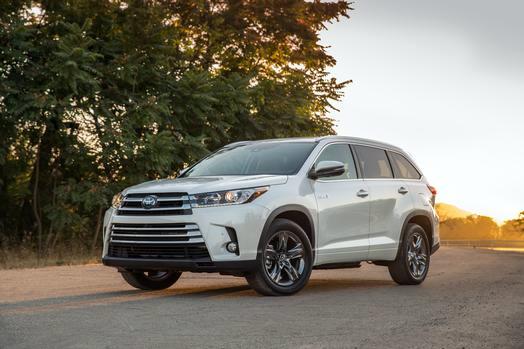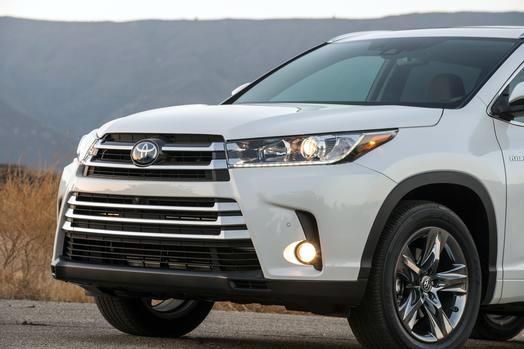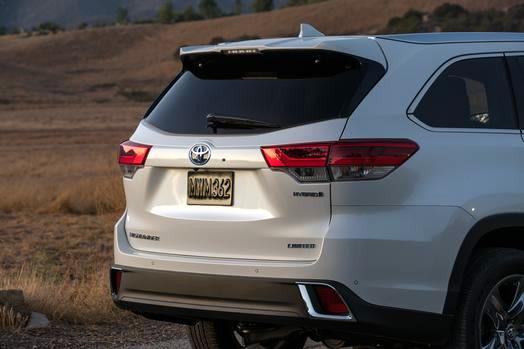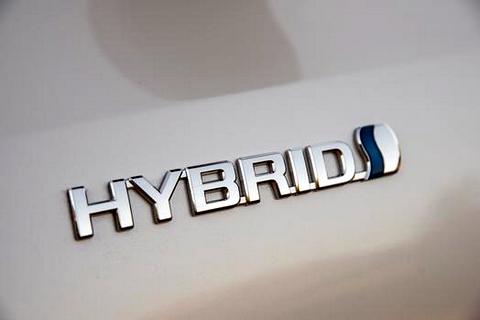Incrementally Greener
The 2017 Toyota Highlander Hybrid adds two electric motors to the upgraded 3.5-liter V6 engine to make a powerful, roomy and slightly cleaner version of Toyota’s family crossover.

For 2017, you can drive home more affordable LE and XLE versions, matching more closely with the gasoline-only lineup. Formerly the Highlander Hybrid was available only in a premium form with the Limited and Platinum models.
The Highlander is one of eight hybrids Toyota sells, cementing its reputation as the hybrid car company. The Prius family makes up half of Toyota’s hybrid stable, but there are two hybrid crossovers, including the smaller RAV4 Hybrid.
One New Engine, Two New Motors
The 2017 Toyota Highlander Hybrid blends a new, more powerful 3.5-liter V6 engine with a set of electric motors, positioned in the front and rear axles. That placement lets them do different jobs. The larger motor in front, with 167 horsepower (hp) and 247 pounds-feet (lb.-ft.) of torque, shares front axle driving chores with the engine. The smaller rear motor, with 68 hp and 103 lb.-ft. of torque, helps drive the rear wheels as part of the standard Electric On-

Demand all-wheel-drive system. This is a different process from the all-wheel-drive system in gasoline-only Highlanders.
The goal of a hybrid vehicle is to use electric motors so you can run the gasoline engine less, reducing fuel consumption. The 2017 Toyota Highlander Hybrid ends up being more powerful than the gasoline version, since it uses the same engine, but adds the electric motors. Total system horsepower is 306, through the odd math you get when combining output from engines and motors.
My Celestial Silver Metallic XLE test car earns fuel economy EPA ratings of 29 mpg city/27 highway/28 combined. Compare that with 20 mpg city and 27 highway for the gasoline version, and you can see that the improvement happens in town. A Start and Stop function turns the engine off when stopped, which helps reduce consumption.
I averaged 25.0 miles per gallon over a week of mixed driving—a bit below the EPA’s estimates. The EPA Green figures, 8 for Smog and 6 for Greenhouse Gas, are better than average.
A Big, Comfortable Machine
The Highlander, now well into its third generation, provides a comfortable ride for a family of up to eight in the lower models, and seven in the higher models, which swap the middle bench for two comfy captain’s chairs. The 4,464-pound crossover excels at mass transit, with easy-to-slide second-row seats for convenient third-row access.

The second and third row seats fold down to open up a big, long load floor. Even with the third row up, you still have 13.8 cubic feet of space behind it. Drop the 60/40 split second row and you’ve got a commodious 42.3 cubic feet.
The body is a little bit updated front and rear for 2017, but Highlander design remains standard Toyota truck fare, with a large, double-stack grill and slim, pulled-back headlamp pods up front. Bold cutouts along the lower doors and fender accents convey the right “macho” feel while still making the Highlander look right at the Opera.
Inside, this SUV has some chunky truck aesthetics, with its dash shelf under sections of black and silver that flow into different masses. The traditional two-gauge instrument panel is flanked by a large rectangular air vent on the left, and on the right the 4.2-inch info screen sits between two tall vents. Below lives a set of traditional climate controls.
Mobile Broadcasting
My tester had a drop-down glasses holder in the ceiling that doubled as a wide-angle mirror for checking out the second- and third-row seat activity. The Driver Easy Speak feature uses a microphone up front to broadcast parental instruction to the rear speakers. This is the first I’ve ever heard of such a thing. There are five USB ports, assuming everybody need a charge or a connection.

The Highlander starts with a well-equipped LE base model and adds some worthwhile upgrades to each level. On the outside, selected LE highlights include LED taillights and stoplights, heated power outside mirrors, 18-inch alloy wheels and privacy glass. The XLE adds more stuff, including blind-spot warning indicators to the mirrors, a power moonroof, a wheel upgrade, roof rails and a handy rear hatch window.
The upper models bump the wheel size to 19 inches and add projector-beam headlamps and puddle lamps on the Limited and a panoramic moonroof and rain-sensing wipers on the Platinum.
Inside, the XLE upgrades from the LE with three-zone automatic climate control, an overhead console, second-row window shades, leather seats and steering wheel, and more. The Limited adds a backup camera, ventilation for the front seats, and auto up and down on the power windows. The Platinum brings in a Bird’s Eye View camera, and even more configurable power seats and steering wheel controls. The complete list is much too long to display here.
Prices and Bottom Lines
Prices start at $37,210 for the LE model. My XLE base-priced at $42,270. The Limited checks in at $45,700, with the Limited Platinum topping out at $48,820. All prices include the $940 destination charge. My car had an optional Rear Seat BluRay DVD entertainment system ($1,810), so it listed for $44,080.
The Highlander fills a popular spot in the Toyota lineup. The Hybrid powertrain increases fuel economy numbers for this commodious family hauler to figures that used to be expected from compact sedans.
Related Stories You Might Enjoy—Toyota Hybrids
News: 2019 Toyota Avalon Hybrid Introduced
Road Test: 2017 Toyota Mirai
Road Test: 2017 Toyota RAV4 Hybrid (Steve’s view)
Road Test: 2017 Toyota RAV4 Hybrid (John’s view)
Road Test: 2017 Toyota Prius Prime (Steve’s view)
Road Test: 2017 Toyota Prius Prime (Larry’s view)
Road Test: 2017 Toyota Prius V
Road Test: 2017 Toyota Prius Prime (John’s view)
Road Test: 2017 Toyota Camry Hybrid
Road Test: 2016 Toyota Prius (Steve’s view)
Road Test: 2016 Toyota Prius (Steve’s view)
First Drive: 2016 Toyota Prius
Road Test: 2014 Toyota Highlander Hybrid
Disclosure:
Clean Fleet Report is loaned free test vehicles from automakers to evaluate, typically for a week at a time. Our road tests are based on this one-week drive of a new vehicle. Because of this we don’t address issues such as long-term reliability or total cost of ownership. In addition, we are often invited to manufacturer events highlighting new vehicles or technology. As part of these events we may be offered free transportation, lodging or meals. We do our best to present our unvarnished evaluations of vehicles and news irrespective of these inducements.
Our focus is on vehicles that offer the best fuel economy in their class, which leads us to emphasize electric cars, plug-in hybrids, hybrids and diesels. We also feature those efficient gas-powered vehicles that are among the top mpg vehicles in their class. In addition, we aim to offer reviews and news on advanced technology and the alternative fuel vehicle market. We welcome any feedback from vehicle owners and are dedicated to providing a forum for alternative viewpoints. Please let us know your views at publisher@cleanfleetreport.com.

4 thoughts on “Road Test: 2017 Toyota Highlander Hybrid”